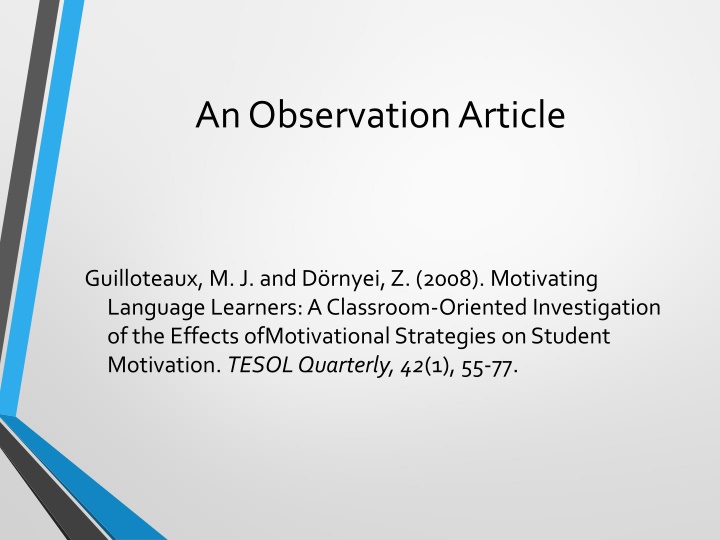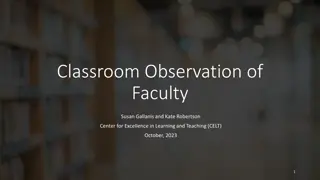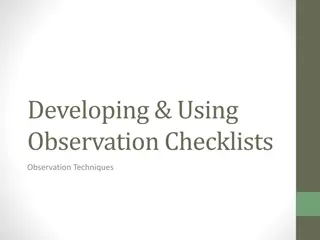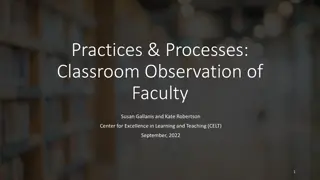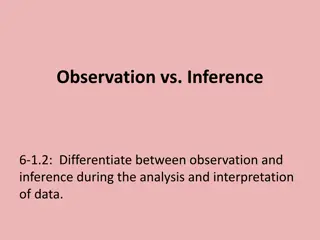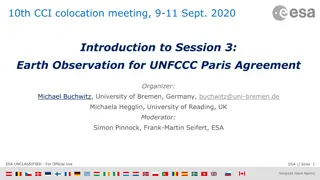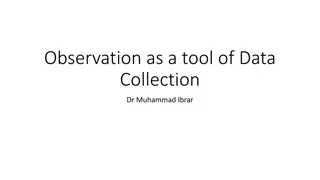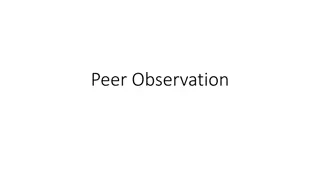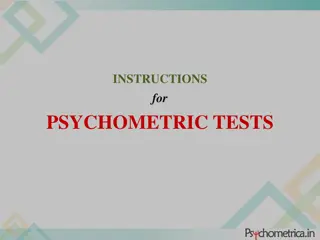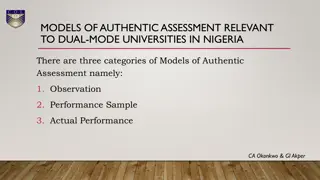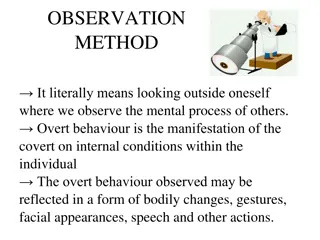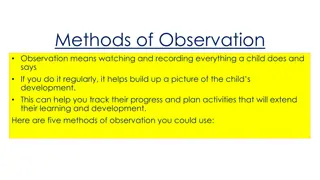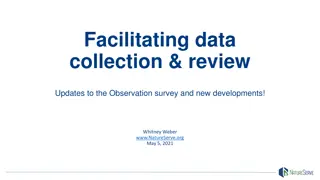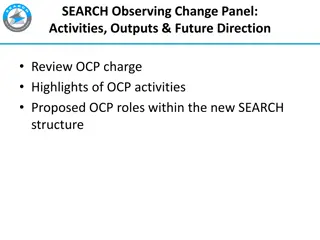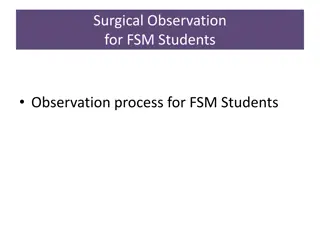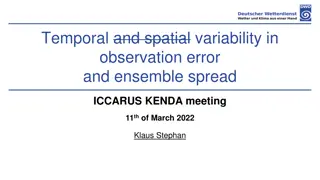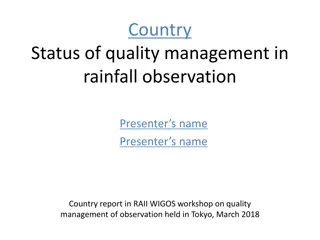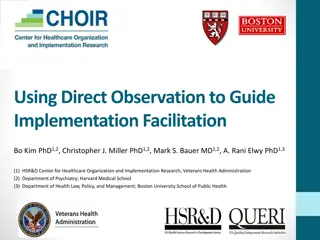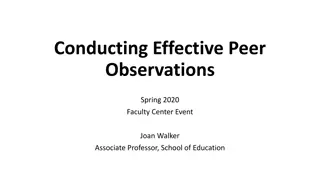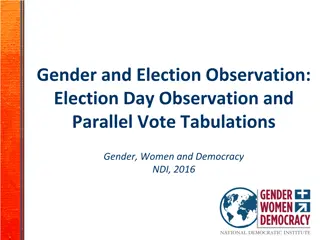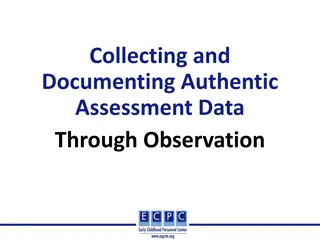An ObservationArticle
This study explores the impact of teachers' motivational strategies on student motivation in ESOL classrooms in South Korea. Results show a positive correlation between teachers' motivational practices and students' motivated learning behavior.
Download Presentation

Please find below an Image/Link to download the presentation.
The content on the website is provided AS IS for your information and personal use only. It may not be sold, licensed, or shared on other websites without obtaining consent from the author.If you encounter any issues during the download, it is possible that the publisher has removed the file from their server.
You are allowed to download the files provided on this website for personal or commercial use, subject to the condition that they are used lawfully. All files are the property of their respective owners.
The content on the website is provided AS IS for your information and personal use only. It may not be sold, licensed, or shared on other websites without obtaining consent from the author.
E N D
Presentation Transcript
An ObservationArticle Guilloteaux, M. J. andD rnyei, Z. (2008). Motivating Language Learners: A Classroom-Oriented Investigation of the Effects ofMotivationalStrategies on Student Motivation. TESOL Quarterly, 42(1), 55-77.
Abstract The teacher's use of motivational strategies is generally believed to enhance student motivation, yet the literature has little empirical evidence to support this claim. Based on a large-scale investigation of 40 ESOL classrooms in South Korea involving 27 teachers and more than 1,300 learners, this study examined the link between the teachers' motivational teaching practice and their students' language learning motivation. The students' motivation was measured by a self-report questionnaire and a classroom observation instrument specifically developed for this investigation, the motivation orientation of language teaching (MOLT). The MOLT observation scheme was also used to assess the teachers' use of motivational strategies, along with a posthoc rating scale filled in by the observer. The MOLT follows the real-time coding principle of Spada and Fr hlich's(1995) communication orientation of language teaching (COLT) scheme but uses categories of observable teacher behaviors derived from D rnyei's(2001) motivational strategies framework for foreign language classrooms. The results indicate that the language teachers' motivational practice is linked to increased levels of the learners' motivated learning behavior as well as their motivational state.
Abstract Background to the study The teacher's use of motivational strategies is generally believed to enhance student motivation, yet the literature has little empirical evidence to support this claim. Based on a large-scale investigation of 40 ESOL classrooms in South Korea involving 27 teachers and more than 1,300 learners, this study examined the link between the teachers' motivational teaching practice and their students' language learning motivation. The students' motivation was measured by a self-report questionnaire and a classroom observation instrument specifically developed for this investigation, the motivation orientation of language teaching (MOLT). The MOLT observation scheme was also used to assess the teachers' use of motivational strategies, along with a posthocrating scale filled in by the observer. The MOLT follows the real-time coding principle of Spada and Fr hlich's(1995) communication orientation of language teaching (COLT) scheme but uses categories of observable teacher behaviors derived from D rnyei's(2001) motivational strategies framework for foreign language classrooms. The results indicate that the language teachers' motivational practice is linked to increased levels of the learners' motivated learning behavior as well as their motivational state.
Abstract Methodology followed The teacher's use of motivational strategies is generally believed to enhance student motivation, yet the literature has little empirical evidence to support this claim. Based on a large-scale investigation of 40 ESOL classrooms in South Korea involving 27 teachers and more than 1,300 learners, this study examined the link between the teachers' motivational teaching practice and their students' language learning motivation. The students' motivation was measured by a self-report questionnaire and a classroom observation instrument specifically developed for this investigation, the motivation orientation of language teaching (MOLT). The MOLT observation scheme was also used to assess the teachers' use of motivational strategies, along with a posthocrating scale filled in by the observer. The MOLT follows the real-time coding principle of Spada and Fr hlich's(1995) communication orientation of language teaching (COLT) scheme but uses categories of observable teacher behaviors derived from D rnyei's(2001) motivational strategies framework for foreign language classrooms. The results indicate that the language teachers' motivational practice is linked to increased levels of the learners' motivated learning behavior as well as their motivational state.
Abstract The teacher's use of motivational strategies is generally believed to enhance student motivation, yet the literature has little empirical evidence to support this claim. Based on a large-scale investigation of 40 ESOL classrooms in South Korea involving 27 teachers and more than 1,300 learners, this study examined the link between the teachers' motivational teaching practice and their students' language learning motivation. The students' motivation was measured by a self-report questionnaire and a classroom observation instrument specifically developed for this investigation, the motivation orientation of language teaching (MOLT). The MOLT observation scheme was also used to assess the teachers' use of motivational strategies, along with a posthoc rating scale filled in by the observer. The MOLT follows the real-time coding principle of Spada and Fr hlich's (1995) communication ori- entation of language teaching (COLT) scheme but uses categories of observable teacher behaviors derived from D rnyei's(2001) motiva- tionalstrategies framework for foreign language classrooms. The results indicate that the language teachers' motivational practice is linked to increased levels of the learners' motivated learning behavior as well as their motivational state. Aspects of findings and future perspectives
Now scan the first part of the research paper up to the heading A Framework for Motivational Strategies . What are the main points in the introduction?
importance of motivation and motivational strategies in language learning reports research which has been done before; develops a rationale for the study; criticises past practices justifies the importance of this study; engages the reader's interest; gives the main purpose of the study provides the context for the study;
Now skim A framework for Motivational Strategies section What are the main points in this part?
Now skim and scan Research Design and Research Questions section What research design did they use? What instruments did they use? What are the research questions
They used a correlational design Using a very structured observational for teachers motivational strategies and students motivational states
Now skim and scan Method until Results and Discussion How is this section written? What sub-sections does Method have? How details is each sub-section?
Participants and context of the study The instruments used and the way they have been developed The procedures followed The way the data have been analyzed
Now read the Computing Composite Variables under RESULTS and DISCUSSION (read the first and the second PARAGRAPHS) no need to read the rest
